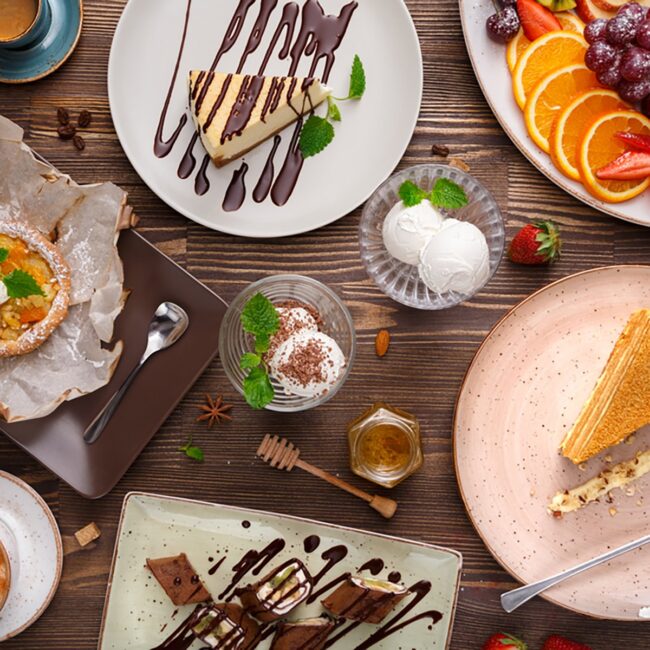
What sets the good bakers apart from the great ones? I’ll reveal some of the keys to converting your baking from good to great – just like the pros.
Experiment With Add-Ins

One of the fundamentals of baking is to follow the ratios – it’s crucial. But, that doesn’t mean you can’t experiment a little with add-ins. For example, do your cookies need to have a more chewy texture? Sub in oats for up to a third of the flour. How about changing the flavor profile by mixing chip flavors (chocolate, peanut butter, butter scotch…) in cookies, brownies and quick breads or add dried fruit or candy. You can even toss a handful of colorful rainbow sprinkles into cake batters, too.
Cut Bars Like A Pro

Most of us grab our knife, eyeball the brownies in the pan, then start cutting. Chances are, none of the squares come out uniform. Getting nice square slices from your brownies and bars is super simple, if you cut them out of the pan. Line your pan with parchment paper, ensuring you have excess hanging over the edges to use as handles. Once baked, lift the slab out of the pan and place onto a cutting board. There you can cut your squares evenly – slicing away hard or tapered edges.
Line Your Pans

Lining your baking pans with parchment paper is more reliable than greasing – Plus, it allows you to transfer your baking without them tearing or falling apart. Also, you can over brown the bottoms of your cookies on a greases sheet; However, on parchment paper they will bake much more evenly. It’s advised to actually cut the parchment paper to fit or you can invest in some pre-cut ones. Another fantastic option is to use silicone liners.
Use Only Fresh

Expiration dates can sneak up on you! As tempting as it may be to use up old ingredients (like spices, chocolate and flours), the result will be lackluster or off-flavor. Using expired leaveners like yeast, baking soda and baking powder will also hurt the rise and texture of breads and cakes. Ditch ’em and replace with something fresh.
Pie Plates

It’s actually more scientific than one would think. But choosing the right pie plate is important.
To get the most reliably browned pie crust bottoms, I suggest a metal pan. Aside from being thinner than a glass plate, the metal plate is also a better conductor of heat.
If you’re using a glass pie plate, position the oven rack down closer to the heating element so the bottom can cook through more easily.
Ceramic pie plates are beautiful to admire your pie in, but they are fairly poor conductors of heat; In-turn, and more likely to give you a soggy bottomed pie.
Bake For Less Time

Check the recipe’s recommended bake time and back off the timer between 3-10 minutes. Oven temperatures differ and you never know if your treats will bake like the recipe suggests! In addition to preventing burnt or dried out baking, some things like fudgy brownies and chewy oatmeal cookies will be more delicious if taken out early.
Plan Ahead

Pre-read the recipe in order to have all of your ingredients and any equipment and utensils ready. Does the recipe call for room temperature eggs and butter? Have them out in advance to warm up.
Also, consider the time of year when choosing a recipe. hot, humid days are tough for making buttercream, pastry dough or croissants. Be sure to have a plan to keep ingredients at a proper temperature, or choose a different recipe.
Be Patient

Ingredients should be the correct temperature – Don’t rush ahead if they are not there yet. Also, patience is key with bake and rise times for breads. Not to forget cooling times before you cut into freshly baked pies, loaves and bars.
Perfectly Sized Cookies

When cookies are plopped on the pan by the tablespoon full, your cookies are most likely going to end up being all different sizes. Invest in a trusty spring-loaded cookie scoop. Once you try it, you will wonder why you hadn’t gotten one sooner. Not only will your cookies all look the same and uniform, the scoop makes the work quicker, cleaner and more fun. The scoops are also wonderful for muffin batter, too. If you can’t get your hands on a cookie scoop, ice cream scoops work almost as good.
Perfect Cup Of Flour

If you’re accustomed to using measuring cups – and your recipe is set up to use measuring cups – then practice dry measuring. Spoon the flour into a dry measuring cup, then level it by taking the back of a knife or icing spatula and pushing it across the top of the cup in order to remove the excess flour.
Sift The Dry Stuff

Many people think that sifting the flour and other dry ingredients is an unnecessary step. But, it’s very necessary if you want to avoid picking lumps out of your batter. Get in the habit of sifting all dry ingredients – especially flour, cocoa powder and confectioner’s sugar. This will allow you to break up clumps before they hit your mixing bowl. The sifter is also great for blending baking soda, baking powder and salt evenly into the other dry ingredients.
Let It Rise

When many home bakers are ready to let their bread dough rise, they make the mistake of putting it in the warmest place possible in order to speed up the process. Like I said, it’s a mistake. To maximize the best possible bread flavor, you want a slow, natural rise. So, find a spot where it’s room temperature and leave your dough there. Don’t rush it.

